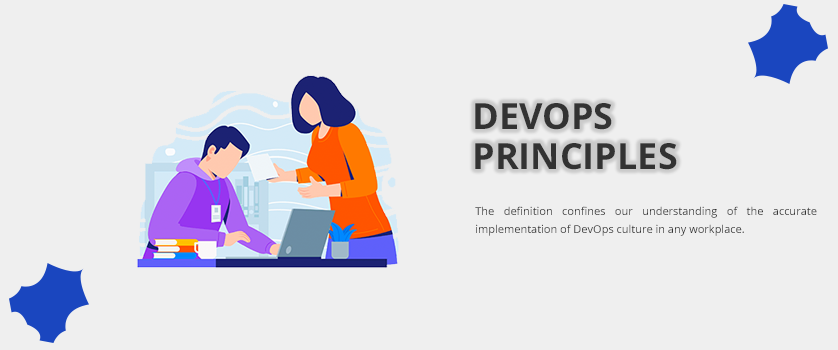
Introduction to DevOps Principles
DevOps is a practice followed by almost all IT giants, as it
is a more collaborative approach towards the software development lifecycle. The term has
originated from an amalgamation of development and operations teams to apply the
principles to deliver superior quality software within a defined SLA.
It is a culture that aims to build a unified perspective
towards the objective to be achieved by integrating development, operations, and quality
assurance teams to incorporate every idea and approach for the solution to be
implemented.
DevOps is thus the adoption of core principles from development and
operations teams such as plan, code, build test and monitor, release, deploy, operate, respectively.-Click to Tweet
DevOps Principles 2022
The definition confines our understanding of the accurate
implementation of DevOps culture in any workplace. Let us look at a few principles that
will help strengthen our knowledge on how DevOps facilitates continuous integration and
deployment in an agile environment.
Following are the DevOps principles:
- Customer-Centric Action:
Customer feedback is very crucial in any endeavor
towards accelerating a company’s market value. The deliverables are meant for
a certain target audience and therefore it is important to implement changes very
frequently, as per requirement. The products and services being developed and
deployed by the IT industry need a continuous implementation of changing market
trends concerning the needs and constraints of the end-user. Therefore, companies
can succeed with the DevOps approach only when they are ready to invest in
innovation and marketing the right strategy to be ahead of their competitors.
- Incremental releases:
Ideally, in older software development processes, any
new feature implementation or an update had to wait for a certain time for its
deployment. This process was error-prone and often led to end-user dissatisfaction.
This drawback is overcome by DevOps, considering the enormity of resources and
solutions available at our behest. In a dynamic market condition, like the prevalent
situation, a company can easily opt for cloud solutions that offer robust features
like automatic provisioning and managing the software development infrastructure.
Once a code is ready, it can be easily deployed on the server, which offers backend
support for implementing the changes in the main product so that the end-users are
not deprived of feature updates or security patch updates.
- Automation:
Considering the dynamicity of the market conditions, a
smart choice would be to choose an automation software solution that would take care
of tests, after each build. This saves a lot of time and effort to be invested by
the stakeholders involved in the development cycle of software.
- End-to-End responsibility:
The terminology states that it is not one party that is
responsible for completing an activity and handing it over to the other team. It is
a cross-culture integration of ideas that places an equal amount of responsibility
and accountability on each stakeholder involved, whether from the development,
operations, or quality assurance teams. Every time there is a new implementation,
the onus lies on each member to complete their part on time.
- Cross-Functional Teams:
The teams should ideally consist of members who are
capable of understanding and handling all kinds of tasks, in terms of whatever
requirements come in or in whichever way. It simply means that the team members need
to possess skill sets in various dimensions such as requirements gathering,
analysis, test analysis, and so on.
- Continuous Improvement:
Efforts towards continuously improving and enhancing the
production environment, as well as integrating changes as per market trends,
technology advancements, customer needs, are crucial for attaining an edge in the
competitive age. DevOps emphasizes waste management, saving time, speed
optimization, and continuous upgrading of software products and
services.
- Continuous Integration:
There is always a change required in a product or
service in terms of feature change, security update, new feature upgrade, and so on.
The objective is to sustain in the long run, with an endeavor to scale up to be at
the forefront, among the end-users. Continuous integration is thus imperative;
therefore, organizations must be aware of the requirements that need to be met and
keep updating their products and services so that not much inconvenience is caused
among the end-users.
- Continuous Delivery:
The code that has been integrated needs to be available
among the users as well. Therefore, once a change is executed, an upgrade
notification should be generated on users’ devices so that the next patch or
update is ready for them and they always remain aware of the changes. Once a code,
uploaded on the server, passes all the required tests, it should be available in the
production environment. This continuous effort is made to improve the product and
services without impacting the performance or the overall productivity of the
team.
- Version Control:
DevOps is a collaboration of different skill sets and
thus there is a need to keep a central repository, which is accessible to all the
members of the team so that they can keep track of the updates being made, in terms
of code upload and deployment. Such a tool or software solution is imperative in
keeping the team on the same track and the very purpose of unity does not go in
vain.
To summarize DevOps culture in nutshell, the team has to
incline constantly to improve their approach towards the work they are doing, a
clear demarcation of the roles and responsibilities within the team. This deeply
emphasizes continuous collaboration, communication, discussion to discuss progress
reports, any roadblocks, or the future path to be taken up for future
projects.
Conclusion:
Organizations are following norms and practices that can ease
their time and effort investments for any deliverable. The onus of adopting a certain
practice and culture lies in the management of any organization by proper planning,
organizing, staffing, and allocation of the required budget to get the best outcome for
their investments.
Any practice, whether DevOps or lean or Kanban, requires a
proper amalgamation of the relevant skill sets to ensure the difficulty to manage tasks
is eased as everyone should ideally possess a set of knowledge of expertise, which will
help them with a more cohesive and result oriented outcome.


